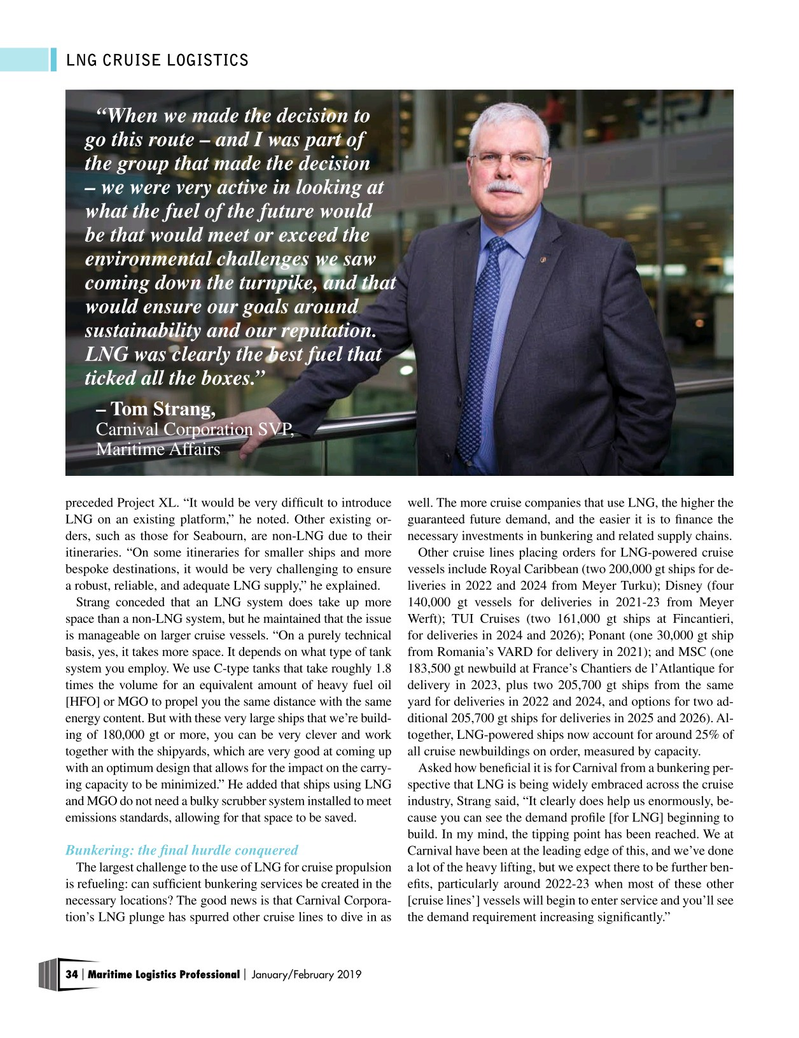
Page 34: of Maritime Logistics Professional Magazine (Jan/Feb 2019)
Cruise Ports Annual
Read this page in Pdf, Flash or Html5 edition of Jan/Feb 2019 Maritime Logistics Professional Magazine
LNG CRUISE LOGISTICS “When we made the decision to go this route – and I was part of the group that made the decision – we were very active in looking at what the fuel of the future would be that would meet or exceed the environmental challenges we saw coming down the turnpike, and that would ensure our goals around sustainability and our reputation.
LNG was clearly the best fuel that ticked all the boxes.” – Tom Strang,
Carnival Corporation SVP,
Maritime Affairs preceded Project XL. “It would be very diffcult to introduce well. The more cruise companies that use LNG, the higher the
LNG on an existing platform,” he noted. Other existing or- guaranteed future demand, and the easier it is to fnance the ders, such as those for Seabourn, are non-LNG due to their necessary investments in bunkering and related supply chains. itineraries. “On some itineraries for smaller ships and more Other cruise lines placing orders for LNG-powered cruise bespoke destinations, it would be very challenging to ensure vessels include Royal Caribbean (two 200,000 gt ships for de- a robust, reliable, and adequate LNG supply,” he explained. liveries in 2022 and 2024 from Meyer Turku); Disney (four
Strang conceded that an LNG system does take up more 140,000 gt vessels for deliveries in 2021-23 from Meyer space than a non-LNG system, but he maintained that the issue Werft); TUI Cruises (two 161,000 gt ships at Fincantieri, is manageable on larger cruise vessels. “On a purely technical for deliveries in 2024 and 2026); Ponant (one 30,000 gt ship basis, yes, it takes more space. It depends on what type of tank from Romania’s VARD for delivery in 2021); and MSC (one system you employ. We use C-type tanks that take roughly 1.8 183,500 gt newbuild at France’s Chantiers de l’Atlantique for times the volume for an equivalent amount of heavy fuel oil delivery in 2023, plus two 205,700 gt ships from the same [HFO] or MGO to propel you the same distance with the same yard for deliveries in 2022 and 2024, and options for two ad- energy content. But with these very large ships that we’re build- ditional 205,700 gt ships for deliveries in 2025 and 2026). Al- ing of 180,000 gt or more, you can be very clever and work together, LNG-powered ships now account for around 25% of together with the shipyards, which are very good at coming up all cruise newbuildings on order, measured by capacity.
with an optimum design that allows for the impact on the carry- Asked how benefcial it is for Carnival from a bunkering per- ing capacity to be minimized.” He added that ships using LNG spective that LNG is being widely embraced across the cruise and MGO do not need a bulky scrubber system installed to meet industry, Strang said, “It clearly does help us enormously, be- emissions standards, allowing for that space to be saved. cause you can see the demand profle [for LNG] beginning to build. In my mind, the tipping point has been reached. We at
Bunkering: the fnal hurdle conquered Carnival have been at the leading edge of this, and we’ve done
The largest challenge to the use of LNG for cruise propulsion a lot of the heavy lifting, but we expect there to be further ben- is refueling: can suffcient bunkering services be created in the efts, particularly around 2022-23 when most of these other necessary locations? The good news is that Carnival Corpora- [cruise lines’] vessels will begin to enter service and you’ll see tion’s LNG plunge has spurred other cruise lines to dive in as the demand requirement increasing signifcantly.” 34 Maritime Logistics Professional January/February 2019 | |

 33
33

 35
35
